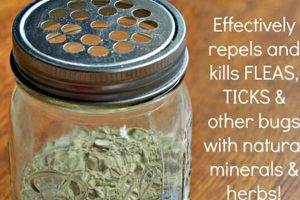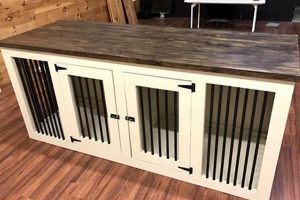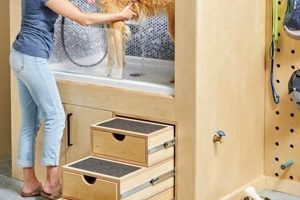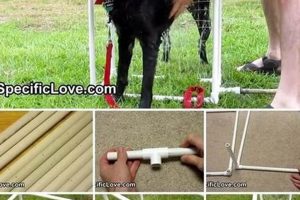The creation of homemade remedies designed to protect canine footpads represents a growing trend among pet owners. These formulations typically consist of natural ingredients chosen for their moisturizing and protective qualities, intended to combat dryness, cracking, and irritation caused by environmental factors. For example, a common preparation might include a combination of shea butter, coconut oil, and beeswax, melted and blended to form a soothing salve applied directly to the animal’s paws.
Such practices provide several benefits. The ability to control the specific ingredients used allows for avoidance of potentially harmful chemicals or allergens found in some commercially available products. Furthermore, crafting a custom solution can be more economical in the long run. Historically, pet owners have sought ways to alleviate discomfort in their animals using readily available natural resources, and this approach echoes that tradition, providing a proactive means of maintaining paw health.
The following sections will delve into the selection of appropriate components, the step-by-step methodology for creating a suitable product, and essential guidelines for proper application and storage to ensure efficacy and safety for the animal. The focus will remain on best practices to promote canine comfort and well-being.
Canine Footpad Salve Formulation
This section provides essential guidelines for the effective creation and application of homemade canine footpad treatments.
Tip 1: Ingredient Sourcing: Procure only high-quality, food-grade ingredients. This minimizes the risk of allergic reactions or ingestion-related health concerns. Prioritize organic options whenever feasible to reduce exposure to pesticides and herbicides.
Tip 2: Beeswax Selection: Opt for natural beeswax, as it provides a protective barrier against environmental irritants. Ensure the beeswax is properly filtered to remove any impurities that could cause irritation.
Tip 3: Oil Selection: Coconut oil offers moisturizing and antimicrobial properties. Shea butter adds emollient qualities, aiding in softening and healing damaged tissue. Olive oil is a viable alternative but should be used sparingly due to its potential to leave a greasy residue.
Tip 4: Melting and Mixing: Employ a double boiler or a heat-safe bowl placed over simmering water to melt ingredients. Avoid direct heat, which can degrade the beneficial properties of the oils. Mix thoroughly to ensure a homogenous blend.
Tip 5: Cooling and Solidification: Pour the mixture into airtight containers and allow it to cool and solidify completely at room temperature. Avoid refrigeration, as this can alter the texture and make application more difficult.
Tip 6: Application Technique: Apply a thin layer to the affected areas of the canine’s footpads. Apply after walks or exposure to harsh environments. Observe the animal for any signs of irritation or allergic reaction following application.
Tip 7: Storage Protocols: Store the preparation in a cool, dark place away from direct sunlight. This will help to preserve the integrity of the ingredients and extend the product’s shelf life. Discard if signs of rancidity or spoilage are observed.
These guidelines facilitate the creation of a safe and effective footpad treatment. Adherence to these principles helps to maintain paw health and enhance the animals overall comfort.
The subsequent section will address potential complications and provide advice on when professional veterinary care is necessary.
1. Ingredient safety
The formulation of homemade canine footpad treatments necessitates a paramount focus on ingredient safety. This is a direct consequence of the potential for both topical exposure and incidental ingestion by the animal. The selection of components lacking inherent toxicity or allergenic properties is therefore not merely advisable but essential for safeguarding canine health.
Failure to adhere to stringent safety standards introduces several risks. For instance, the inclusion of certain essential oils, while often touted for their aromatic benefits, can prove toxic to canines when ingested. Similarly, the incorporation of low-quality or refined waxes may contain residual solvents that can cause localized skin irritation or, upon ingestion, gastrointestinal distress. A real-world example involves the use of tea tree oil, considered safe for humans in diluted forms, which has been reported to cause neurological symptoms and liver damage in canines. The understanding of safe concentration levels is essential to mitigate the risk. Similarly, cocoa butter can cause serious heart problems, seizures, and even death. This highlights the practical significance of thoroughly researching and selecting only non-toxic substances and ensuring appropriate concentrations.
In summary, ingredient safety forms the cornerstone of responsible homemade canine footpad treatment. It directly impacts the animal’s health and well-being. The challenge lies in maintaining vigilance in ingredient selection, recognizing potential hazards, and prioritizing the use of food-grade, canine-safe alternatives. This emphasis aligns with the broader theme of responsible pet ownership and proactive healthcare practices.
2. Proper formulation
The efficacy and safety of homemade canine footpad treatments are intrinsically linked to their proper formulation. A well-formulated salve or balm ensures adequate protection against environmental stressors while minimizing the risk of adverse reactions. This is critical, as canine paws are continuously exposed to varying terrains and weather conditions, necessitating a balanced blend of protective and emollient ingredients.
- Lipid Balance
Maintaining a balance between occlusive lipids (such as beeswax) and emollient oils (such as shea or coconut oil) is essential. The occlusive component forms a protective barrier against moisture loss and external irritants, while emollients soften and hydrate the footpad. An imbalance, characterized by excessive occlusives, may lead to a stiff, impermeable layer, potentially trapping moisture and fostering bacterial growth. Conversely, an excess of emollient oils may render the balm ineffective in providing lasting protection against abrasion or chemical exposure. For instance, a formulation with a high concentration of olive oil may leave a greasy residue, failing to offer sustained barrier properties on surfaces like hot pavement. The optimal ratio ensures both protection and hydration.
- Humectant Inclusion
The incorporation of a humectant, such as a small amount of honey or vegetable glycerin, can enhance the moisturizing capacity of the formulation. Humectants attract moisture from the environment, drawing it into the skin and promoting hydration. However, excessive use may render the footpad overly moist, predisposing it to fungal infections. The careful addition of humectants is therefore crucial, balancing the benefits of increased hydration with the potential risks of microbial overgrowth. Real-world experience indicates that a concentration of no more than 5% is generally advisable.
- Anti-inflammatory Agents
The inclusion of gentle anti-inflammatory agents, such as calendula or chamomile extracts, can aid in soothing irritated or inflamed footpads. These ingredients possess inherent anti-inflammatory properties that can mitigate discomfort resulting from minor abrasions, allergic reactions, or environmental irritants. The concentration must be carefully controlled to avoid potential sensitization. Formulations intended for canines with known sensitivities should prioritize hypoallergenic and non-irritating options. For example, the use of essential oils known to be irritants, even in diluted forms, should be strictly avoided.
- Antimicrobial Considerations
While not always necessary, the inclusion of a mild antimicrobial agent can be beneficial in formulations intended for canines prone to bacterial or fungal infections. Coconut oil, with its inherent antimicrobial properties, is often used for this purpose. However, potent synthetic antimicrobials should be avoided in homemade preparations due to the risk of disrupting the natural skin microbiome. The reliance on natural antimicrobial agents, coupled with proper hygiene practices, offers a balanced approach to preventing infection without compromising skin health. The effect of such applications might be more noticeable during wet season.
In summary, proper formulation of canine footpad treatments entails a careful consideration of ingredient ratios, functionalities, and potential interactions. It’s not simply combining ingredients, but understanding their roles and effects. The considerations help in ensuring optimal protection, hydration, and healing. Through informed decisions, proper formulation supports the overall goal of maintaining healthy and resilient canine paws.
3. Application frequency
The temporal aspect of applying homemade canine footpad treatments represents a critical determinant in their overall effectiveness. Frequency directly influences the maintenance of footpad hydration, protection against environmental hazards, and the prevention or mitigation of existing dermatological conditions. Optimal frequency depends on a confluence of factors, including environmental conditions, activity levels, and the specific formulation employed.
- Environmental Exposure
The surrounding environment exerts a significant influence on application frequency. Canines exposed to abrasive surfaces, extreme temperatures, or chemical irritants necessitate more frequent applications. For example, walking on hot asphalt during summer months can rapidly deplete footpad moisture, necessitating application both before and after exposure. Similarly, winter conditions characterized by ice, snow, and de-icing salts warrant increased frequency to counteract the drying and irritating effects of these elements. Conversely, canines residing in temperate environments with limited exposure to harsh conditions may require less frequent applications.
- Activity Level
A canine’s activity level directly correlates with the wear and tear experienced by its footpads, impacting the required application frequency. Highly active dogs engaged in strenuous exercise or extended outdoor activities experience greater footpad abrasion and moisture loss, thus necessitating more frequent balm applications. Conversely, sedentary canines with limited outdoor exposure may require less frequent applications. Observing the animal’s behavior and footpad condition after activity can provide valuable insights into determining appropriate application intervals. For instance, signs of dryness, cracking, or sensitivity indicate a need for increased frequency.
- Formulation Characteristics
The specific characteristics of the homemade footpad treatment dictate the appropriate application frequency. Formulations containing occlusive agents, such as beeswax, tend to provide longer-lasting protection, potentially reducing the need for frequent reapplication. Conversely, formulations relying primarily on emollient oils may require more frequent application to maintain adequate hydration and barrier function. Understanding the composition and intended action of the specific formulation is therefore crucial in determining the optimal application schedule. For example, lighter balm containing primarily oils need more frequent applications that richer balms which have wax.
- Pre-existing conditions
For canines with pre-existing footpad conditions, such as hyperkeratosis, fissures, or allergic dermatitis, the application frequency may need adjustment to facilitate healing and manage symptoms. Increased frequency may be warranted during flare-ups or periods of heightened irritation. In such cases, consulting a veterinarian to determine the underlying cause and appropriate treatment plan is advisable, as homemade treatments may serve as a supportive measure but not a replacement for professional veterinary care. If you already have treatment you may want to increase frequency to enhance healing.
In summary, application frequency is not a static parameter but rather a dynamic variable that must be adjusted based on individual canine needs and environmental conditions. Thoughtful observation of the animal’s behavior, footpad condition, and exposure to environmental stressors allows for informed adjustments to application frequency, maximizing the effectiveness of homemade footpad treatments in maintaining canine comfort and well-being.
4. Storage conditions
The efficacy and longevity of homemade canine footpad treatments are directly influenced by storage conditions. Improper storage can degrade active ingredients, alter the consistency of the product, and promote microbial contamination, thereby diminishing its therapeutic value and potentially posing a risk to the animal. The delicate balance of oils, waxes, and other components within a homemade balm necessitates a stable environment to maintain optimal properties. Exposure to excessive heat, light, or humidity initiates chemical reactions and physical changes that compromise the integrity of the formulation. For instance, exposure to direct sunlight can cause oxidation of unsaturated oils, leading to rancidity and a reduction in their emollient qualities. Similarly, fluctuations in temperature can induce phase separation, resulting in a grainy or uneven texture that affects application.
Ideal storage practices involve maintaining the product in a cool, dark, and dry environment. Airtight containers constructed of opaque materials, such as amber glass or dark-colored plastic, are recommended to minimize light exposure and prevent moisture ingress. Refrigeration can extend the shelf life of certain formulations, particularly those containing heat-sensitive ingredients, but should be approached with caution, as it can also alter the balm’s consistency, making it difficult to apply. For example, a beeswax-based balm stored in a refrigerator becomes excessively hard, requiring significant warming before use. Careful consideration of the formulation’s composition and the local climate conditions is crucial in determining the most suitable storage method. Proper storage minimizes the risk of degradation and ensures that the footpad treatment remains effective and safe for its intended purpose.
In summary, storage conditions constitute an integral element of responsible homemade canine footpad treatment preparation. Adherence to recommended storage protocols, including temperature control, protection from light and moisture, and the use of appropriate containers, extends the product’s shelf life, preserves its therapeutic properties, and minimizes the risk of adverse effects. Overlooking the importance of storage compromises the effort invested in ingredient selection and formulation, potentially negating the benefits intended for the animal’s well-being.
5. Canine tolerance
Canine tolerance represents a critical, and often underestimated, factor in the successful application of homemade footpad treatments. Its significance stems from the inherent variability in individual canine sensitivities and the potential for adverse reactions to specific ingredients commonly employed in DIY formulations. A product meticulously crafted with seemingly benign components may, in fact, elicit a negative response in a particular animal, ranging from mild skin irritation to more severe allergic reactions. For example, an ingredient such as lanolin, frequently used for its emollient properties, can trigger allergic dermatitis in susceptible canines. Thus, an understanding of canine tolerance is not merely a precautionary measure but a fundamental prerequisite for responsible footpad care using homemade remedies. The effect of any formulation may range from beneficial to harmful depending on individual dog.
Practical application of this understanding necessitates a cautious and methodical approach. Before widespread application of any homemade balm, a small test area should be treated, and the animal observed for at least 24-48 hours for any signs of adverse reactions, such as redness, itching, swelling, or excessive licking. If any such signs are observed, use of the formulation should be discontinued immediately, and a veterinarian consulted if symptoms persist or worsen. The careful selection of ingredients known to be generally well-tolerated by canines, such as shea butter or coconut oil, can minimize the risk of adverse reactions. Furthermore, avoiding the use of essential oils, which are known to be potent irritants and potential toxins for dogs, is crucial for maximizing safety. The presence or lack of adverse reaction in one dog doesn’t guarentee similar response of the other, so testing must be carried out for each individuals.
In summary, canine tolerance is an indispensable consideration in the “dog paw balm diy” context. It underscores the importance of individualized assessment, careful ingredient selection, and diligent observation to ensure the safety and efficacy of homemade footpad treatments. Challenges lie in the inherent difficulty of predicting individual sensitivities and the potential for delayed reactions. However, by adhering to a cautious and informed approach, pet owners can minimize the risks associated with homemade remedies and promote the well-being of their canine companions, with veterinarian oversight when needed.
Frequently Asked Questions
This section addresses common inquiries regarding the creation and use of homemade footpad treatments for canines.
Question 1: Can all vegetable oils be safely used in a homemade formulation?
Not all vegetable oils are suitable for canine footpad treatments. Certain oils, such as those high in linoleic acid, can become rancid quickly, potentially causing irritation. Prioritize oils known for their stability and emollient properties, such as coconut or shea butter.
Question 2: Is beeswax a necessary component, or can it be substituted?
Beeswax provides a protective barrier, but alternatives exist. Candelilla wax or carnauba wax can serve as vegan substitutes, though they may alter the texture and consistency of the final product. Proper research must precede substitution to ensure suitability and safety.
Question 3: How can one determine if a canine is allergic to a particular ingredient in the balm?
Conduct a patch test before widespread application. Apply a small amount of the product to a discrete area of the skin and monitor for signs of irritation, such as redness, itching, or swelling, over a 24-48 hour period. Discontinue use immediately if adverse reactions occur.
Question 4: What is the expected shelf life of a homemade canine footpad treatment?
The shelf life depends on ingredient stability and storage conditions. Generally, a properly stored balm can last for 6-12 months. Discard the product if it exhibits signs of rancidity, discoloration, or changes in odor or texture.
Question 5: Can essential oils be safely added to enhance therapeutic benefits?
The use of essential oils requires extreme caution. Many essential oils are toxic to canines, even in diluted forms. Consult a veterinarian or qualified aromatherapist experienced in canine aromatherapy before incorporating any essential oils into the formulation.
Question 6: How often should the balm be applied for optimal results?
Application frequency depends on environmental factors, activity levels, and the severity of footpad dryness or damage. A general guideline is to apply the balm 1-3 times daily, particularly before and after exposure to harsh conditions. Adjust the frequency as needed based on individual canine requirements.
These FAQs provide foundational knowledge for creating and using homemade canine footpad treatments responsibly. Prioritizing ingredient safety, proper formulation, and careful observation is crucial for ensuring the well-being of the animal.
The subsequent section will address the legal and ethical considerations surrounding the creation and distribution of homemade pet care products.
Concluding Remarks on Canine Footpad Salve Formulation
This exploration of ” dog paw balm diy” underscores the importance of informed decision-making in canine care. Successful formulation requires careful consideration of ingredient safety, balanced composition, appropriate application frequency, and proper storage conditions. Understanding individual canine tolerance is paramount, mitigating risks associated with sensitivities or allergic reactions. The information presented serves as a guide for responsible pet owners seeking to create customized solutions for canine footpad maintenance.
Continued vigilance in monitoring product efficacy and potential adverse effects is essential. Homemade remedies should complement, not replace, professional veterinary care. As pet owners, a proactive and well-informed approach to canine footpad health ensures the well-being of animal companions, fostering responsible care practices.







